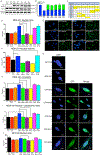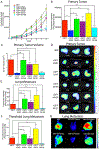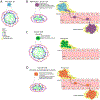Defects in Emerin-Nucleoskeleton Binding Disrupt Nuclear Structure and Promote Breast Cancer Cell Motility and Metastasis
- PMID: 33771882
- PMCID: PMC8254762
- DOI: 10.1158/1541-7786.MCR-20-0413
Defects in Emerin-Nucleoskeleton Binding Disrupt Nuclear Structure and Promote Breast Cancer Cell Motility and Metastasis
Abstract
Nuclear envelope proteins play an important role in regulating nuclear size and structure in cancer. Altered expression of nuclear lamins are found in many cancers and its expression is correlated with better clinical outcomes. The nucleus is the largest organelle in the cell with a diameter between 10 and 20 μm. Nuclear size significantly impacts cell migration. Nuclear structural changes are predicted to impact cancer metastasis by regulating cancer cell migration. Here we show emerin regulates nuclear structure in invasive breast cancer cells to impact cancer metastasis. Invasive breast cancer cells had 40% to 50% less emerin than control cells, which resulted in decreased nuclear size. Overexpression of GFP-emerin in invasive breast cancer cells rescued nuclear size and inhibited migration through 3.0 and 8.0 μm pores. Mutational analysis showed emerin binding to nucleoskeletal proteins was important for its regulation of nuclear structure, migration, and invasion. Importantly, emerin expression inhibited lung metastasis by 91% in orthotopic mouse models of breast cancer. Emerin nucleoskeleton-binding mutants failed to inhibit metastasis. These results support a model whereby emerin binding to the nucleoskeleton regulates nuclear structure to impact metastasis. In this model, emerin plays a central role in metastatic transformation, because decreased emerin expression during transformation causes the nuclear structural defects required for increased cell migration, intravasation, and extravasation. IMPLICATIONS: Modulating emerin expression and function represents new targets for therapeutic interventions of metastasis, because increased emerin expression rescued cancer metastasis.
©2021 American Association for Cancer Research.
Conflict of interest statement
Figures







Similar articles
-
The Role of Emerin in Cancer Progression and Metastasis.Int J Mol Sci. 2021 Oct 19;22(20):11289. doi: 10.3390/ijms222011289. Int J Mol Sci. 2021. PMID: 34681951 Free PMC article. Review.
-
Emerin deficiency drives MCF7 cells to an invasive phenotype.Sci Rep. 2024 Aug 28;14(1):19998. doi: 10.1038/s41598-024-70752-5. Sci Rep. 2024. PMID: 39198511 Free PMC article.
-
The cell cycle dependent mislocalisation of emerin may contribute to the Emery-Dreifuss muscular dystrophy phenotype.J Cell Sci. 2002 Jan 15;115(Pt 2):341-54. doi: 10.1242/jcs.115.2.341. J Cell Sci. 2002. PMID: 11839786
-
Emerin organizes actin flow for nuclear movement and centrosome orientation in migrating fibroblasts.Mol Biol Cell. 2013 Dec;24(24):3869-80. doi: 10.1091/mbc.E13-06-0307. Epub 2013 Oct 23. Mol Biol Cell. 2013. PMID: 24152738 Free PMC article.
-
The nuclear envelope LEM-domain protein emerin.Nucleus. 2013 Jul-Aug;4(4):298-314. doi: 10.4161/nucl.25751. Epub 2013 Jul 17. Nucleus. 2013. PMID: 23873439 Free PMC article. Review.
Cited by
-
Observing bioorthogonal macrocyclizations in the nuclear envelope of live cells using on/on fluorescence lifetime microscopy.Chem Sci. 2024 Aug 20;15(36):14913-23. doi: 10.1039/d4sc03489a. Online ahead of print. Chem Sci. 2024. PMID: 39184298 Free PMC article.
-
Nuclear Dynamics and Chromatin Structure: Implications for Pancreatic Cancer.Cells. 2021 Oct 1;10(10):2624. doi: 10.3390/cells10102624. Cells. 2021. PMID: 34685604 Free PMC article. Review.
-
The expression and role of the Lem-D proteins Ankle2, Emerin, Lemd2, and TMPO in triple-negative breast cancer cell growth.Front Oncol. 2024 Apr 24;14:1222698. doi: 10.3389/fonc.2024.1222698. eCollection 2024. Front Oncol. 2024. PMID: 38720803 Free PMC article.
-
The nuclear envelope and metastasis.Oncotarget. 2023 Apr 14;14:317-320. doi: 10.18632/oncotarget.28375. Oncotarget. 2023. PMID: 37057891 Free PMC article. No abstract available.
-
The role of inner nuclear membrane proteins in tumourigenesis and as potential targets for cancer therapy.Cancer Metastasis Rev. 2022 Dec;41(4):953-963. doi: 10.1007/s10555-022-10065-z. Epub 2022 Oct 7. Cancer Metastasis Rev. 2022. PMID: 36205821 Free PMC article. Review.
References
Publication types
MeSH terms
Substances
Grants and funding
LinkOut - more resources
Full Text Sources
Other Literature Sources
Medical

